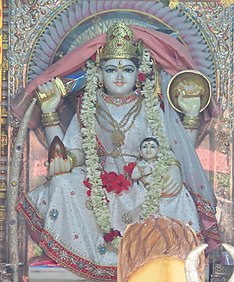
Brahmani or Brahmi, is one of the seven Hindu mother goddesses known as Sapta Matrikas. She is a form of Saraswati and is considered as the Shakti of the creator god Brahma in Hinduism. She is an aspect of Adi Shakti, possessing the "Rajas Guna" and is therefore the source of Brahma's power.
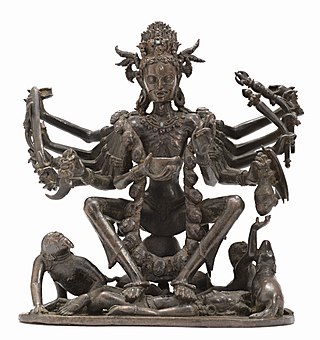
Chamunda, also known as Chamundeshwari, Chamundi or Charchika, is a fearsome form of Chandi, the Hindu mother goddess, aka Shakti and is one of the seven Matrikas.

Kutch district, officially spelled Kachchh, is a district of Gujarat state in western India, with its headquarters (capital) at Bhuj. Covering an area of 45,674 km2, it is the largest district of India. The area of Kutch is larger than the entire area of other Indian states like Haryana (44,212 km2) and Kerala (38,863 km2). The population of Kutch is about 2,092,371. It has 10 talukas, 939 villages and 6 municipalities. The Kutch district is home to the Kutchi people who speak the Kutchi language.

Jalore Fort is the main attraction of Jalore, a town in the Indian state of Rajasthan, one of the nine castles of the Maru, under the Paramaras in the 10th century. It is one of the most famous and impressive forts in the state and has been known through history as the Svangiri or the "golden mount".This fort is a symbol of the valor of Songra Chauhans. The Songra Chauhans made their name all over the world by defeating a cruel Turkic emperor like Alauddin. Veer Veeramdev and Rao Kanhadded Dev defeated a power like Alauddin from this fort to protect their motherland with their valorous might. This fort is a symbol of the valor of Songra Chauhans.With the blessings of Kuldevi Maa Ashapura who is also known as Modara Mata. Chauhan gave a different direction to Jalore and to the fort.
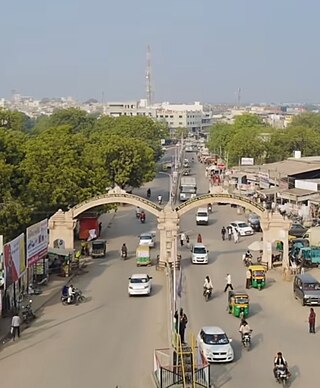
Tharad is a town in Tharad taluka in the Banaskantha district of the state of Gujarat in India. It is the administrative center of Tharad taluka. Tharad is near the border of Gujarat, 40 km from the border with Pakistan and 15 km from the Indian state of Rajasthan. Its main industries are agriculture and diamond polishing. It is one of the first major towns in Gujarat on National Highway 15.

A kuladevata, also known as a kuladaivaṃ, is an ancestral tutelary deity in Hinduism and Jainism.

The Sachchiya Mata Temple is a Hindu temple located in Osian, near Jodhpur city in the Indian state of Rajasthan.
Nadol is a census town in Desuri tehsil of Pali district, India. Ashapura Mataji temple and Shri Nadol Tirth attract pilgrims.
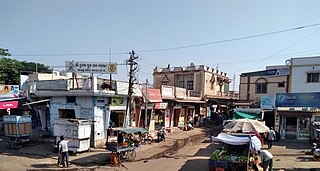
Kukma or Kookma is a village near the Bhuj town, taluka in Kachchh District of Indian State of Gujarat. It is located at a distance of 16 kilometers from Bhuj, the headquarters of Kachchh District.
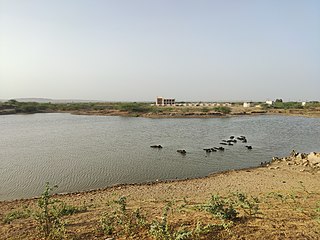
Kumbharia or Kumbhariya is a village in Anjar Taluka of Kutch District of Gujarat State of India. It is situated at a distance of 14 km from Anjar town, the taluka headquarters.

Mata no Madh is a village in Lakhpat Taluka of Kutch district, Gujarat, India. The village lies surrounded by hills on both banks of a small stream and has a temple dedicated to Ashapura Mata, the household deity of former Jadeja rulers of kutch State. She is also considered patron deity of Kutch. The village is located about 105 km from Bhuj, the headquarters of Kutch district.

Ghumli is a village located 45 km from Jamkhambhaliya, at foothills of Barda, in Devbhumi Dwarka district of Gujarat, India.

Harsidhhi, one of the aspects of Durga, is a regional Hindu goddess, popular in Gujarat, Madhya Pradesh, adjoining Maharashtra states of India.

Kutch, also spelled Kutch or Kachchh and also historically known as the Kingdom of Kutch, was a kingdom in the Kutch region from 1147 to 1819 and a princely state under British rule from 1819 to 1947. Its territories covered the present day Kutch region of Gujarat north of the Gulf of Kutch. Bordered by Sindh in the north, Cutch State was one of the few princely states with a coastline.
Khengarji I (1510-1585) was an Indian ruler belonging to Jadeja clan of Rajputs. He was the ruler of Morbi from 1538-1585 and later became ruler of Cutch, assuming title of Rao of Cutch, ruling unified Cutch from 1548 to 1585.
Modheshwari Mata is an aspect of the devi Parvati or Mahakali. She is the clan deity of the Modh community of Gujarat.
Jethwa dynasty was a dynasty that ruled over present day Gujarat region of India from 7th century AD till middle of 20th century, when India became independent. It was a Rajput dynasty ruled by Jethwa clan of Rajputs.
Delwara, nestled in the Aravalli Range hills, is a small town about 28 kms away from Udaipur, Mewar, and close to Eklingji Temple, on the way to the temple town of Nathdwara, in the state of Rajasthan, India. Delwara was originally known as ‘Devkul Patan Nagri’, which means the town of god. It boasted over 1500 temples at one time, out of which there were over 400 Jain temples. Delwara was the center of learning and culture before the 15th century AD. Around the middle of the 13th century, Raja Sagar, a Deora Chauhan and a descendant of Rao Kirtipal of Jalore, was a very brave king of Delwara (Mewar). Descendants of Raja Sagar sacrificed their lives whilst fighting alongside Ranas of Mewar against Muslim invaders. Raja Sagar was the progenitor of Bachhawat and Bothra clan of Oswals. Sagar's son, Kunwar Bohitya was immensely influenced and inspired by Jain philosophy. Samdhar, a grandson of Bohitya and a Deora Chauhan, was the first man in his genealogy to convert to Jainism.

Momai or Momai Mata also known as Dashama is a regional Hindu goddess, popular in Gujarat, especially in desert region of Kutch.
Kshemkari Mata temple is an old temple of Mother Goddess Kshemkari, also known as Khimaj Mata situated on a [mountain], located at Latitude 24.998°N and Longitude 72.239°E, in Bhinmal, Jalore District of Rajasthan. It is 25 km from Sundha Mata Temple. Khimaj Mata was a Kuldevi of Solanki Rajput.


